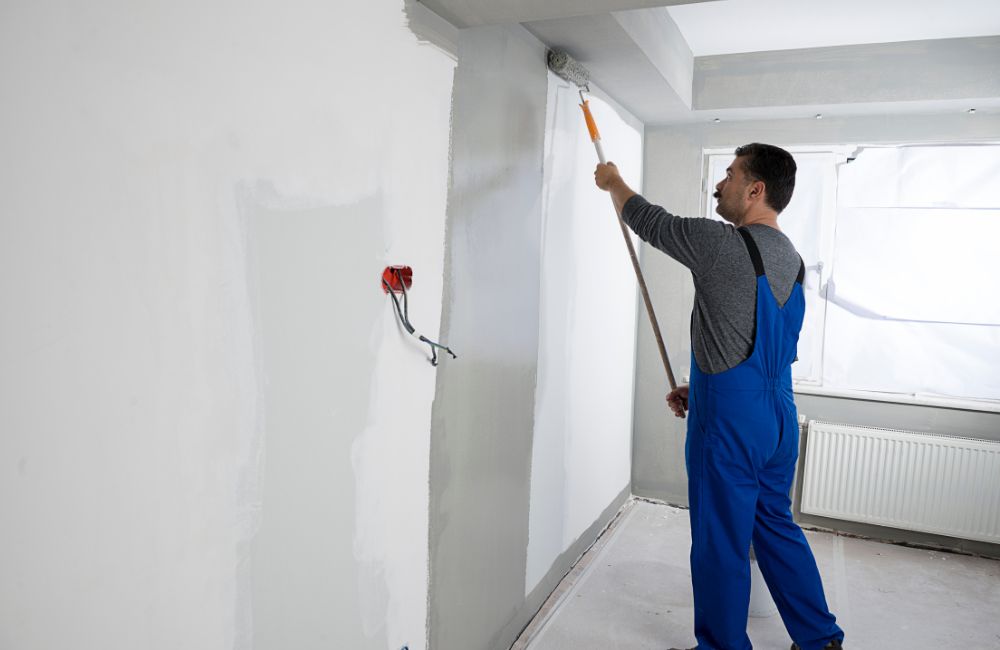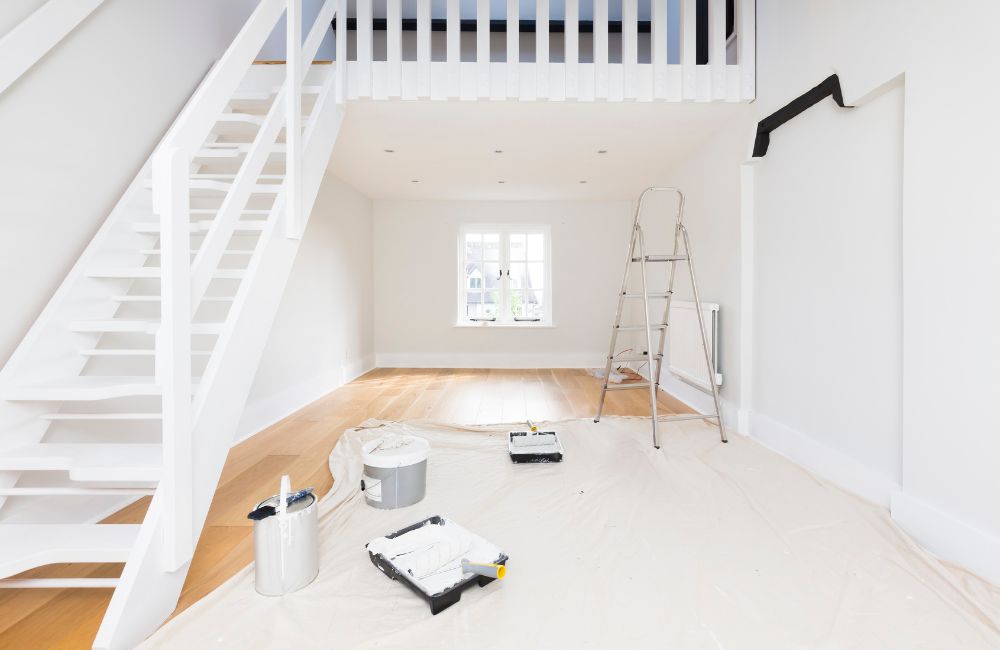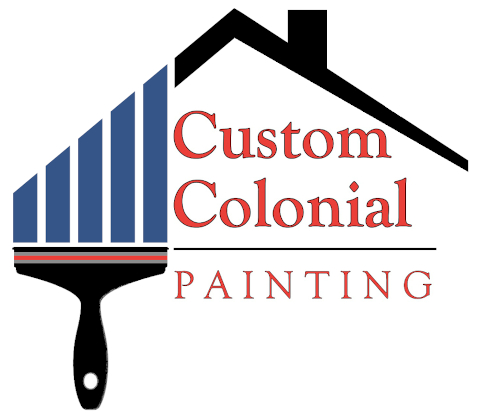Table of Contents
Key Takeaways
5 Tips to Minimize Paint Fumes and Improve Indoor Air Quality
Tip 1: Choose Low-VOC or No-VOC Paints
Tip 2: Ensure Proper Ventilation
Tip 3: Use Air Purifiers
Tip 4: Seal Off Painting Area
Tip 5: Allow Adequate Drying Time Before Reoccupying
Frequently Asked Questions
Ensure a Safer Home with Professional Painting Services!
| Key Takeaways ✔ Opt for low-VOC or no-VOC paints to minimize harmful chemicals released into the air. ✔ Keep windows open and use fans to improve airflow during and after painting. ✔ Run air purifiers to help remove lingering paint fumes and improve indoor air quality. ✔ Isolate the painting area with plastic sheeting to contain fumes and prevent them from spreading. ✔ Wait until the paint is fully dry and cured before reoccupying the space to ensure safety. |
Painting your home can bring a fresh, vibrant look, but it also comes with the challenge of managing paint fumes, which can impact your indoor air quality. These fumes, often filled with volatile organic compounds (VOCs), can cause discomfort and even pose health risks if not properly managed. Fortunately, with the right precautions from house painters in Westport, CT, you can enjoy your newly painted space without compromising your air quality.

5 Tips to Minimize Paint Fumes and Improve Indoor Air Quality
A fresh coat of paint can do wonders for a room, but the fumes it leaves behind are less desirable. To ensure a healthier environment, here are five practical tips to reduce paint fumes and improve indoor air quality during and after your painting project.
Tip 1: Choose Low-VOC or No-VOC Paints
Paint fumes often contain volatile organic compounds (VOCs), which are gasses emitted from certain solids or liquids. VOCs encompass a range of chemicals, some of which can have both short- and long-term adverse health effects if not properly managed. Fortunately, with the right precautions, you can enjoy your newly painted space without compromising your air quality.
Health Risks of VOCs
Children, elderly individuals, and those with pre-existing health conditions are more susceptible to the harmful effects of VOCs. House painters are particularly concerned with VOCs because of the following health risks:
-
- Short-Term Effects: Eye, nose, and throat irritation, headaches, and nausea.
-
- Long-Term Effects: Increased risk of cancer, damage to the liver, kidneys, and central nervous system.
Choosing the Right Paint
When selecting a paint, consult with your house painters to ensure you’re choosing the best low-VOC or no-VOC option for your needs. Some well-known brands offer a wide range of colors and finishes in low-VOC formulas, so you don’t have to sacrifice quality or aesthetics for safety.
-
- Check Labels: Look for paints labeled as low-VOC or no-VOC.
-
- Consider the Finish: Some finishes may have higher VOCs, so always check the specifics.
-
- Consult House Painters: Professional house painters can recommend trusted brands and products that have proven effective in maintaining indoor air quality.
Tip 2: Ensure Proper Ventilation
When undertaking a painting project, whether it’s a single room or an entire house, ensuring proper ventilation is crucial. House painters emphasize that good ventilation helps to disperse paint fumes, reducing the concentration of harmful chemicals in the air. These fumes, primarily from solvents in the paint, can cause headaches, dizziness, and other health issues if inhaled in large quantities. Additionally, proper ventilation also helps the paint to dry more quickly and evenly.
Tips for Improving Airflow
To maintain excellent indoor air quality during your painting project, house painters recommend several strategies to improve airflow:
-
- Open Windows and Doors: The simplest way to ensure proper ventilation is by opening as many windows and doors as possible. This creates a cross-breeze that helps to quickly disperse paint fumes. Ideally, try to paint on days when the weather allows for this kind of ventilation.
-
- Use Exhaust Fans: If the room has an exhaust fan, such as in a bathroom or kitchen, make sure it’s turned on during painting. These fans are designed to remove air from inside and vent it outside, which can be particularly effective in small or enclosed spaces.
-
- Utilize Portable Fans: Position portable fans to blow air out of the room you’re painting. Place one fan in a window facing outward to help push fumes outside, and another fan on the opposite side of the room to draw fresh air in. Consider using high-velocity fans for larger spaces, as these can move a significant amount of air more effectively.
-
- Create a Cross-Ventilation System: House painters often create a cross-ventilation system by placing fans in different areas to direct the flow of air. For example, one fan can blow fresh air in through a window, while another fan expels air from an opposite window or door. This setup ensures continuous air movement, which is key to minimizing fumes.
-
- Keep Air Circulating After Painting: Even after you’ve finished painting, continue to ventilate the space. It can take several days for paint to fully cure, during which time it will continue to emit fumes. House painters recommend leaving windows open or running fans for at least 24 to 48 hours post-painting.
Tip 3: Use Air Purifiers
House painters often recommend using air purifiers as an effective way to reduce these fumes and maintain a healthier indoor environment. Air purifiers work by drawing in air, filtering out harmful particles and chemicals, and releasing clean air back into the room. High-quality air purifiers are equipped with specialized filters that can trap VOCs and other toxins, significantly reducing the concentration of paint fumes in the air.
Recommendations on Types of Air Purifiers Suitable for This Purpose
House painters recommend choosing air purifiers that are specifically designed to handle chemical pollutants. Here are some key features of air purifiers that are most effective in removing paint fumes:
-
- HEPA Filters: While HEPA (High-Efficiency Particulate Air) filters are excellent at capturing fine particles such as dust and allergens, they alone are not sufficient for filtering out VOCs. So, for paint fumes, house painters suggest choosing an air purifier with an activated carbon filter. Activated carbon is highly effective at absorbing VOCs and other chemicals, helping to neutralize paint fumes in the air.
-
- UV-C Light: Some advanced air purifiers use UV-C light technology to break down VOCs at a molecular level. This technology can be particularly effective in destroying harmful chemicals found in paint fumes.
-
- CADR (Clean Air Delivery Rate): House painters recommend selecting an air purifier with a high CADR rating, which indicates how quickly the purifier can clean the air in a room. A higher CADR rating ensures that the air purifier can efficiently remove paint fumes from the air.
-
- Portability: Portable air purifiers allow house painters to move the unit from room to room as they work, ensuring that all areas are effectively treated for paint fumes.
Tips for Using Air Purifiers During Painting
House painters often suggest the following best practices when using air purifiers to handle paint fumes:
-
- Run the Air Purifier Continuously: Keep the air purifier running throughout the painting process and for several days afterward to ensure that all fumes are removed.
-
- Position the Air Purifier Strategically: House painters recommend placing the air purifier close to the area being painted for maximum effectiveness.
-
- Combine With Ventilation: While air purifiers are powerful tools, they work best when used in combination with proper ventilation, such as opening windows and doors.

Tip 4: Seal Off Painting Area
By sealing off the painting area, you can contain paint fumes within a specific space, preventing them from spreading throughout the entire house. This not only helps in maintaining a healthier environment but also ensures that the fumes dissipate more quickly in a confined area.
Why Contain Fumes in One Area?
Before diving into the “how,” it’s important to understand the “why.” Containing paint fumes in one area has several benefits:
-
- Minimizes the Spread of Fumes: Reduces the amount of fumes circulating throughout your home.
-
- Easier Ventilation: A smaller, contained area is easier to ventilate effectively.
-
- Protects Other Rooms: Keeps other areas of the house free from lingering odors and potential toxins.
Tools and Materials Needed
To effectively seal off a painting area, house painters recommend gathering the following materials:
-
- Plastic Sheeting: To cover large openings, windows, and floors.
-
- Painter’s Tape: For securing the plastic sheeting and protecting surfaces from paint.
-
- Door Seals or Draft Stoppers: To block gaps under doors and prevent fumes from escaping.
-
- Zip Wall or Temporary Wall Systems: Optional but useful for creating a more structured barrier.
Steps to Seal Off the Painting Area
Sealing off the area to contain fumes protects the rest of your living space from exposure but also makes the painting process safer and more efficient. Here are the essential steps from house painters to effectively seal off the painting area.
-
- Clear the Space: Remove all furniture and items from the room you’ll be painting. This makes it easier to set up barriers and ensures your belongings don’t absorb paint fumes.
-
- Cover Doors and Windows: Use plastic sheeting to cover any doors and windows in the painting area. Secure the sheeting with painter’s tape along the edges to ensure a tight seal. House painters recommend overlapping sheets by a few inches to create a more effective barrier.
-
- Cover the Floor: Lay down plastic sheeting on the floor to protect it from paint splatters and to prevent fumes from seeping through floor gaps.
-
- Seal Door Gaps: Use Door Seals or Draft Stoppers: Place door seals or draft stoppers at the base of doors leading out of the painting area. This is especially important for preventing fumes from escaping into hallways and other rooms.
-
- Set Up Zip Walls: If you’re working in a large, open space, consider using zip walls or temporary wall systems. These can be set up quickly to create a semi-permanent barrier, containing fumes more effectively than plastic sheeting alone.
-
- Double-Check for Gaps: After setting up your barriers, walk around the area and check for any gaps where fumes could escape. House painters advise paying close attention to corners and where the plastic sheeting meets the walls.
-
- Limit Access: Once the area is sealed off, limit access to the room. The fewer times the door is opened, the better the containment will be.
Tip 5: Allow Adequate Drying Time Before Reoccupying
Sufficient drying and curing time before reoccupying the space is very important. Paint emits fumes as it dries, and even low-VOC or no-VOC paints can release some level of volatile compounds that affect indoor air quality. House painters often stress that rushing back into a freshly painted room can expose you to unnecessary health risks. Allowing the paint to fully dry and cure significantly reduces the presence of harmful fumes in the air.
Recommendations on Waiting Times
The drying and curing time for paint can vary depending on several factors, including the type of paint used, the humidity level, and the temperature of the room. Interior house painters typically provide the following guidelines:
Water-Based (Latex) Paints
-
- Dry to the touch: 1-2 hours
-
- Recoat time: 4-6 hours
-
- Full cure time: 2-3 weeks
Oil-Based Paints
-
- Dry to the touch: 6-8 hours
-
- Recoat time: 24 hours
-
- Full cure time: 7 days to 2 weeks
High-Humidity Environments
-
- Drying time: Expect longer drying times.
-
- Ventilation: Increase ventilation to speed up the process.
Ideal Waiting Time Before Reoccupying
-
- Water-Based Paints: Wait at least 24-48 hours before using the space, especially for bedrooms or living areas.
-
- Oil-Based Paints: Wait a minimum of 72 hours, ideally up to a week, to ensure that the paint has fully dried and most fumes have dissipated.
Additional Tips from House Painters
-
- Test the Dryness: Gently touch a small, inconspicuous area of the wall. If it feels tacky, give it more time.
-
- Avoid Heavy Usage: Even after the initial drying time, avoid heavy use of the space (e.g., hanging pictures or placing furniture) until the paint has fully cured, as this can affect the finish.
Related post: Tips on Budget-Friendly Interior House Painting
Frequently Asked Questions
Is it safe to sleep in a freshly painted room?
It’s generally recommended to wait at least 24 to 48 hours before sleeping in a freshly painted room, particularly if oil-based or high-VOC paints were used. During this time, the majority of paint fumes should dissipate, reducing the risk of inhaling harmful chemicals while you sleep. Ensure that the room is well-ventilated by keeping windows open and using fans to help clear the air. If you’re particularly sensitive to smells or chemicals, or if young children or pregnant women will be using the room, it’s wise to wait even longer until the fumes are barely noticeable.
Can houseplants help reduce paint fumes in a room?
Certain houseplants are known to help reduce indoor air pollutants, including VOCs commonly found in paint fumes. Plants such as the peace lily, spider plant, and snake plant have been shown to absorb toxins like formaldehyde, benzene, and xylene from the air. While houseplants can help improve air quality, they should not be relied upon as the sole method for removing paint fumes. It’s still essential to ensure proper ventilation and to use low-VOC paints when possible.
What should I do if I accidentally inhale a large amount of paint fumes?
If you accidentally inhale a large amount of paint fumes, it’s important to move to an area with fresh air immediately. Symptoms such as dizziness, nausea, headache, or shortness of breath may occur, and it’s crucial to avoid further exposure. Sit or lie down in a comfortable position, and breathe deeply to help clear your lungs. If symptoms persist or worsen, seek medical attention promptly, as prolonged exposure to concentrated paint fumes can be harmful.
How can I safely dispose of leftover paint and reduce the risk of fumes?
Proper disposal of leftover paint is essential to avoid releasing harmful fumes and chemicals into the environment. Unused paint should never be poured down the drain or thrown in the regular trash. Instead, take it to a local hazardous waste disposal facility, where it can be handled safely. To minimize waste, buy only the amount of paint you need, and consider storing any remaining paint in a cool, dry place with a tightly sealed lid to prevent the release of fumes.
How do paint fumes affect pets, and how can I protect them?
Paint fumes can be harmful to pets, just as they are to humans. Animals, especially birds, are more sensitive to the chemicals found in paint fumes and can experience symptoms like coughing, sneezing, lethargy, and difficulty breathing. To protect your pets, it’s best to keep them out of the area being painted and ensure the space is well-ventilated. After painting, allow the room to air out completely before letting pets back in. If possible, relocate your pets to a different part of the house or a friend’s home until the fumes have dissipated to avoid any potential health risks.

Ensure a Safer Home — Hire Professional Painting Services!
Maintaining a healthy indoor environment is crucial, especially when it comes to painting your home. At Custom Colonial Painting, we prioritize your safety and the air quality in your home. Whether you’re looking to refresh a single room or your entire home, our experienced team is here to provide expert interior painting services in Westport CT.
Trust us to deliver a cleaner, safer, and more beautiful space in Westport, CT. Contact Custom Colonial Painting today to schedule your project and experience the difference that professional care can make.









